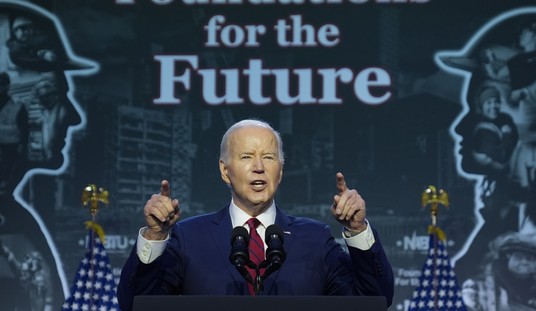We most often hear about the alarming $15.96 trillion national debt (more than 100% of GDP), and the 2012 budget deficit of $1.1 trillion (6.97% of GDP). As dangerous as those numbers are, they do not begin to tell the story of the federal government’s true liabilities.
The actual liabilities of the federal government—including Social Security, Medicare, and federal employees’ future retirement benefits—already exceed $86.8 trillion, or 550% of GDP. For the year ending Dec. 31, 2011, the annual accrued expense of Medicare and Social Security was $7 trillion. Nothing like that figure is used in calculating the deficit. In reality, the reported budget deficit is less than one-fifth of the more accurate figure.
I’m not actually worried about it. Washington is going to hit the wall — fall off the cliff, set its hair on fire, whatever — long before those other bills come due.
Already it’s safe to say there’s no market for the amount of debt Washington is already issuing. Last year the Fed, the lender of last resort, bought up three-quarters of all of DC’s new debt. 77%. It will do about the same this year.
It used to be that when Congress wanted to borrow money, it went hat-in-hand to America’s savers. But Americans stopped saving enough for DC’s appetites, so Congress went to Japan to borrow, then to China. And since Japan and China had to do something with all those dollars they’d gotten from selling us cars and consumer electronics, why not?
These days Japan has troubles of its own, and China seems somewhat less interested in buying securities with a payout lower than the rate of inflation. Go figure.
But fear not! Congress need not go hat in hand to anyone, so long as Ben Bernanke is willing to run the printing presses and use his Make Believe Dollars to buy all the real debt Congress and the president can dream up. And inflation remains low (except for buyers of food and fuel and other exotic goods) because nobody in the private sector is doing much buying. They’re staying hunkered down, trying to avoid being beaten by ObamaCare and the EPA and reenergized union thugs.
It’s further down the line where things get really interesting.
As previously noted, there is not enough demand in the whole entire world for all the new debt we produce each year — but at least it’s cheaper than producing oil pipelines, right? Anyway. There also exists no politically feasible plan for getting our deficits very much under a trillion dollars a year, every year, for as far as the eye can see. Yes, unemployment checks aren’t going out with the same happy ferocity they were a couple of years ago, but entitlement spending is going nowhere but up. And eventually, Uncle Ben is going to have to stop conjuring up Make Believe Dollars.
Because eventually the economy will pick up some steam. It’s at that point that Uncle Ben has to start selling bonds, to hoover up all those Make Believe Dollars he’s been injecting into the economy. If he doesn’t, they’ll run around in their trillions, chasing the same number of goods. This is what we call “nasty inflation.”
But Congress will still want to sell its trillion dollars worth of debt each year, right up against Uncle Ben’s Crazy Treasury Fire Sale.
Let’s assume all this happens about four years from now. By then, we’ll already have outstanding debts of about $20 trillion. And most of that debt is in short term treasuries of two- or three-year maturities. Now, as that debt matures, we can do one of two things. We can roll it over into new debt (refinance), or we can pay it off and send folks home with oodles of cash money.
Stop laughing. We could so pay it off. In some other reality.
Last year we had to refi almost three trillion in existing debt, on top of the trillion in new debt Congress created. So when we get to this next part, I want you to remember that there is already no market big enough to gobble up four trillion dollars in US debt. It doesn’t exist.
When and if that recovery comes, we’ll have Congress still trying to scare up buyers for a trillion dollars in debt each year. We’ll have the Fed trying to unload some unspecified number of trillions — nobody other than The Bearded One is allowed to know that number — in fairly short order. And we’ll have the Treasury trying to refi three, four trillion or more dollars, each and every year.
In a global marketplace that could only buy (or re-fi) a little over three trillion dollars, we’ll have to find the wherewithal to soak up five or six trillion dollars.
Hey, buyer’s market! Think of it — the Treasury, the Fed, Congress, all trying to sell you trillions. They’ll really have to jack up interest rates, won’t they? treasuries you wouldn’t sniff at when they paid out 2% start looking pretty good at 4%, don’t they?
Oh, wait… that’s only for the new debt Congress issues, and for the old debt being re-financed. What about the trillions Ben needs to unload?
Well, kids, here’s where we need a very quick lesson on how bond markets work. A bond pays out a fixed interest rate, no matter who holds it. So let’s say I paid face value for a $100 treasury paying 2%. My $100 investment pays me $2 every year. (Actually, every 360 days — but that’s another lesson.) Now I want to sell that instrument, but interest rates have doubled to 4%. Who’s going to buy my old $100 at 2%, when they can buy a shiny new $100 bond at 4%? Well, nobody. Nobody would be willing to buy at face value.
Instead I offer to sell you my $100 bond for $50. The bond still pays the same $2 a year to you, even though you bought it at half price. And a $100 at 2% bond you bought on the secondary market for $50, gives you the same rate of return as a new $100 at 4% bought at face value.
Ben needs to sell old debt. Tim Geithner at Treasury needs to refi existing debt. Congress needs to issue new debt.
Congress will be the ones offering jacked up interest rates. Ben and Timmy will be the ones offering steep discounts. And this is where the whole system breaks down.
Ben’s problem is the discount he’ll have to offer. If rates really do double to 4% (which is historically still quite low) he won’t be able to take all of his Make Believe Dollars out of circulation. In fact, he’ll only be able to soak up about half of them. Say hello to my leetle fren, inflation.
Tim has a different problem. He’ll soak up some of the Make Believe Dollars that Ben missed. So we have that going for us, which is nice. But the new treasuries he issues in their place will have to offer the same 4% rate being offered on the new debt. And with inflation becoming a problem, that 4% rate won’t last for long — it will have to go up to 5% in short order, and we could see 10% or higher, if inflation really kicks in.
And this starts to do very nasty things to our national balance sheet. Last year, we spent about $225 billion financing our existing debt. That is, paying out those $2 to everybody holding a $100 bond. Over the next four years, that will rise to nearly $300 billion, even with interest rates staying the same. That’s about half of what we spend on defense.
As interest rates rise, so does the vig Congress has to come up with every year. At 5%, interest on the debt eclipses all of defense spending, and starts to equal Social Security. Or Medicare/Medicaid combined. It might even dwarf ObamaCare.
But we haven’t gotten to the worst part.
Yes, interest rates need to go up to stave off inflation. Interest on new debt issuance must also go up, to attract buyers.
“But,” you might ask, “didn’t we already discuss that fact that there already aren’t enough buyers?”
Yes, yes we did. But you can always find a buyer — at the right price. And that’s going to put additional downward pressure on the price Bernanke gets for his old debt. It’s also going to put additional upward pressure on the interest paid on new debt.
Bernanke might be selling for pennies on the dollars. Congress might have to pay 20%, and interest consumes ever-larger chunks of the budget. There comes a point where people simply stop buying, because they don’t believe that the debt at those prices can be honored.
Which brings us to massive inflation because Ben can’t sell, and national bankruptcy because Congress can’t borrow.
There’s a word for that situation: Greece.
And the only thing that has to happen for all of this to come true … is pretty much nothing. This is money already spent. These are programs already mandated. It’s baked in.
We can’t tax our way out of it, because there aren’t enough millionaires and billionaires. We can’t borrow out way out, because we ran out of lenders years ago. The best we can hope for is that the Fed manages to keep inflation relatively tame. That is, 10% for four years. And that rate for that duration cuts the value of the dollar by about half.
Yes, Bernanke will chop the top off of your savings. But he’ll also wrangle that $20 trillion in debt down to a more manageable $10 trillion, so that Congress can keep paying out the goodies to the voters who don’t possess any savings.
And those voters outnumber you and are more politically active than you — that was proven decisively three weeks ago. If you receive benefits, it doesn’t matter if a Big Mac costs $12, provided your benefits are indexed to inflation (and they are).
But you, you poor sap who set aside something for retirement or for a rainy day…
…it’s the destruction of your savings that will make it possible for some other guy to pay $12 for that Big Mac. Because it’s either that, or Greece. Or Zimbabwe. Or worse.
That’s the real fiscal cliff, and we’ve been puttering towards it now for a long time. The only question remaining is if we keep puttering, or if we hit the gas.









Join the conversation as a VIP Member